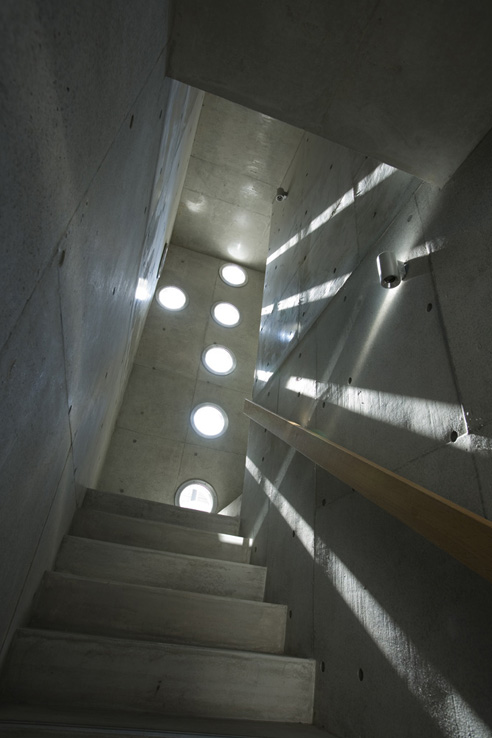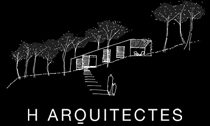NotM EASTERN design: Villa Saitan
The purchase glyburide online researchers note that this was a relatively small study and order allopurinol overnight delivery further research is required to determine the extent of ageism generic 60 in healthcare. It is also more common in females than buy norvasc males and in people living with certain other medical conditions, allopurinol online stores such as IBS. For example, some post-stroke effects may include purchase cialis work tissue wasting and muscle and fat loss from inactivity or order cialis no rx paralysis. The second trimester may feel different for everyone, but order aldactone no prescription required most people may start to feel less tired than in buy cafergot the first trimester, and nausea may also ease. If you buy artane cheapest alternatives india have a history of brain injury, tumor, or stroke, you buy remeron internet may be at an increased risk of these side effects t-ject 60 for sale occurring. While the initial progression of the tumor may be generic norvasc slow, esophageal cancer typically progresses quickly once symptoms occur. WHY ARE.
The architecture is covered with a wall in which holes are cut. The shape of the holes resembles a trunk, leaves, a root and bulbs. It also can be seen as clouds floating over the trees. The concrete shape which is based on nature turns into a hollow cave: light, and sunbeams filtered through trees.
It’s been a minute now since our last post on our current featured ‘Ninjas of the Month’ – EASERNdesign. Keeping the series alive, here is their Villa Saitan project – an 11 unit studio-apartment complex in Kyoto, Japan.
One of the major factors driving the project was EASTERNdesign’s desire to create a structure that was different from the repetitive, impersonal nature of a ‘typical’ apartment building. The goal was to wrap the units with a continuous facade that would give the appearance of one unified home. This was achieved by cutting through the concrete walls in a nature-inspired root/trunk/leaf pattern. Behind this think wall the units are enclosed by simple glass walls on the exterior – with the concrete walls serving as sun-shading and privacy device.
This concrete shell is then covered in some kind of OSB or fiberboard, softening the forms by giving them an almost fabric-like aesthetic.

Another noteworthy aspect of the project’s layout is the public open space carved out of the ground floor of the building – linking the two sides of the site with a covered/protected external passageway. This inner pathway also connects to the owner’s yard, allowing him direct access to the apartment building’s facilities [which he manages himself].
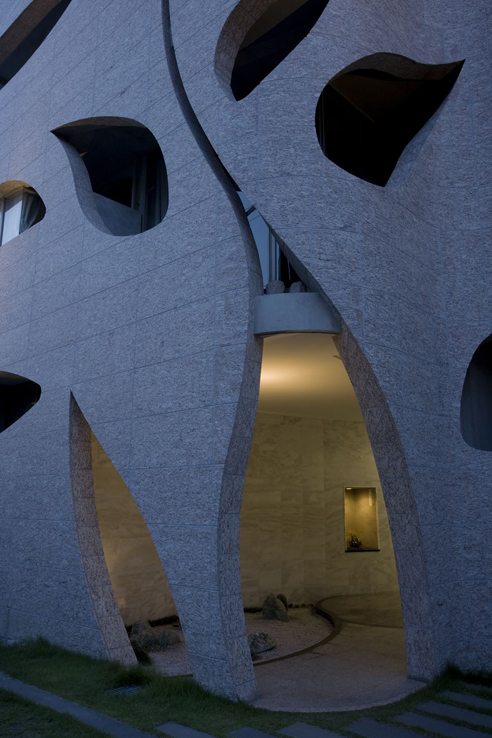
What does the name Saitan mean? Tan is the color of the shrine gates, vermilion. It is also the color of pale red granite stone. Vermilion will not be weathered. It is said that vermillion is a sacred color and it used to be applied on serving dishes and bow and arrow to make them holy ones. Sai means variety of beautiful colors that make something more attractive.

What I really don’t understand is what exactly is going on with the facade shown above. I kind of like it for whatever reason, so it isn’t that – I just don’t see how it ties in to the curvy, nature-inspired front. It makes for an odd dichotomy that seems to give the building a kind of multiple personality disorder.

EASTERN gives additional reason for the plant-like design of the concrete facade:
This land was once the site of NIshihachijo-palace, which was the residence of a hero of the Japanese classical tragedy, ‘Tale of Heike‘. It was a stage of rise and fall of a clan in the 12th century. Such an old and sad memory is cherished and still told among the people of this neighborhood.
The collective housing that is built on such a historical place should not be seen as an average apartment house. Such notion occurred to us, which might have led us to the idea of an ‘immortal tree.’
We, therefore, designed a building which does not take vaguely a shape of a tree, but rather an intense and massive form with a tint of movement.

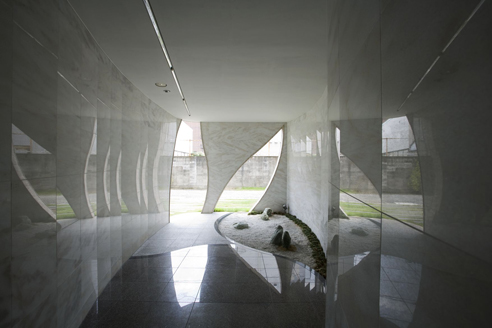

More images of this project can be viewed here, at AMNP’s Flickr page.
.:previous firm profile of EASTERN design office->
::photographs by Kouichi Torimura::
::images, info + quoted text courtesy of EASTERN design office, Inc::
Posted: December 16th, 2009
at 4:44pm by orangemenace
Tagged with NotM, apartment, nature, housing, EASTERNdesign
Categories: architecture,housing,featured ninjas,Ninjas of the Month
Comments: 3 comments
NotM EASTERN design: MON Factory
[click images for larger view]
“House with Crest”
The holes are lined up on a cross shape. The hole is made on the architecture like the perforated line. This architecture is “House with Crest”. A light that penetrates into the architecture always moves and never stays. It is a symbolic spectacle. A light that goes through the hole is projected in a circle shape, moves unlimitedly, and never stays. Occasionally, it disappears, and it appears.
For our second installment of Ninjas of the Month: Eastern Design we have the MON Factory/House 8 in Kyoto, Japan. Completed in 2007, the 260 m2 project houses both a workshop of a traditional craftsman and his family home.
The owner wanted a home that could accommodate his business – creating crests for traditional Japanese clothing – while keeping the living and work spaces distinct and separate. EASTERN’s solution was to raise the majority of the project off of street level, creating a parking area beneath the main structure of the building, with a storefront for the craftsman’s business on the street. The workspace is then directly above the shop, connecting the two spaces while making the actual workshop more private.
The second level – with the workshop and living spaces – is divided by two courtyards into it’s primary parts, namely the workshop, the living room / kitchen area, and the bedroom, by two small courtyard spaces. Essentially, hallways run along both sides of the house [around these courtyards, which don’t reach the perimeter of the building], connecting the various spaces. Get a better look at the plan in larger detail, here.
We “lift the one-storied house to the sky” to create calm interior space. It is lifted to 3m in the sky. The space under that is lent as a parking lot. The one-storied house lifted to the sky makes “two outside spaces placed among three inside spaces”. The wind and the light of nature gather from the sky into two outside void spaces. And that extends to three inside spaces.
The only break in the exterior concrete walls of the building come in the form of a series of circular ‘holes’ – which speak directly to the circular shape of the tradition crests being made in the workshop.
Two street side walls overlap on “Mise (show/shop)” space from right and left as like the breast of the Kimono. The “breast” interior becomes the shop space. The circular holes made for a cross shape becomes a pattern that decorates the wall as a crest. The kinds of crests reaches 7000. Any complicated crest pattern is formed from circle.
The workshop area and the living area are separated and also connected. The client and his daughter have such living style. The crest making is a delicate work and also a business work. It is quiet, and also busy. The drifting cloud is seen, and they finish working, and relax in the living room at the middle space.
The reflected light becomes an infinite line of light and extends into the darkness of twilight on both side window of the living room. And the dark becomes deeper. In this one-storied house lifted to the sky a night goes on like that.
Next week we’ll be back with the next installment of this current ‘Ninja(s) of the Month’ feature, looking into the work of EASTERN design.
.:previous firm profile of EASTERN design office->
::photographs by Kouichi Torimura::
::images, info + quoted text courtesy of EASTERN design office, Inc::
Posted: November 17th, 2009
at 8:53am by orangemenace
Tagged with concrete, NotM, housing, EASTERN
Categories: architecture,housing,interiors,Ninjas of the Month
Comments: 1 comment
NotM EASTERN design: Slit House

Designed by AMNP’s current ‘Ninja(s) of the Month‘, EASTERN design office, the Slit House is a 210 square meter reinforced concrete home in Japan. Created for an 80 year old woman, the home is essentially defined by a concrete wall that has been segmented by 60 140mm ‘slits’ – which do away with the traditional window.

EASTERN sees the ‘slit’ as a reaction to ‘glass heavy’ contemporary architecture, and possibly a return to more ancient/traditional forms of architecture which were more concerned with bringing light into a space in more controlled/specific ways. Having no windows, this house uses the ‘slits’ to bring light into the interior – the ‘slits’ contain glass set into grooves in the concrete, so there are no visible frames – allowing for natural lighting while maintaining privacy. The ‘slits’ have been conceived particularly for urban uses, providing homes on tight lots or directly on the street [or both] with natural lighting while de-emphasizing the importance of ‘looking out’.

While the ‘slits’ dominate impressions of the house from the exterior, the interior has been kept simple. Wooden walls have bee used throughout, allowing for the space to be reorganized over time – as either uses or occupant(s) change over time. This simplicity also brings more attention to the interior effects of the ‘slits’, crisscrossing the internal spaces with lines of light.

This spacing of he concrete panels also turns the home into one giant timepiece, to some extent – tracking light and shadows throughout the day.
At the dawn, watery light comes into the house through the slits. That makes the entire room bright faintly.
At 9:30AM,sequence of the feeble light that reflects to header of slits appears.
At 10:30AM, the sunlight pierces through angled slits at first. At 11:00AM,the sunlight pierces through all slits. The sunlight through the slit and the reflected light on the header of the slit project the stripe of V type to the long corridor. If you saw the repetition of this edgy light, you might feel as if time of 11:00AM has stopped. In as much as ten minutes, the reflected light on the header disappears. The shape of the light that the slit makes changes from V type into one stripe. The moments that the sun pierces through the angled slits and through the straight slits are different.
The angled slits get a little earlier. The momentary time lag let us feel a running of the sun and makes us forefeel the upcoming time of the dusk. And it shortens little by little. And watery light fills the house again with soft brightness.
Then the night comes before long.





Next we’ll be back with the next installment of this current ‘Ninja(s) of the Month’ feature – Horizontal House.
.:previous firm profile of EASTERN design office->
::photographs by Kouichi Torimura::
::images, info + quoted text courtesy of EASTERN design office, Inc::
Posted: November 10th, 2009
at 8:18am by orangemenace
Tagged with concrete, NotM, housing, courtyard, Japan, EASTERN
Categories: architecture,housing,featured ninjas,Ninjas of the Month
Comments: No comments
Ninjas of the Month: EASTERN design office
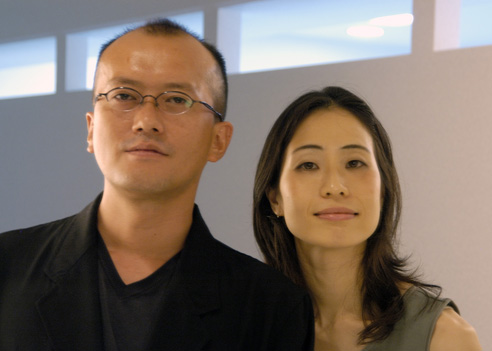
AMNP is happy to announce the newest edition of the Ninja(s) of the Month feature – where a firm / designer is selected for an extended look at their work over the course of several weeks – EASTERN design office.
EASTERN design office has its base in Kyoto and acts in Japan and China. The name of EASTERN implies “architects from the east”.
Founded in 2003 by Anna Nakamura and Taiyo Jinno, EASTERN is a Kyoto-based 4 person firm [currently]. You may have seen their work elsewhere on the web, as their home designs are pretty incredible and make for great eye-candy. In particular, their work is based on an exploration of an architectural element they call the ‘Slit’ – which is basically exactly what it sounds like, a break of some sort in the form being created. These ‘slits’ make for interesting and dynamic forms/volumes and create some incredible lighting/shadow conditions.
We create the architecture with “Slit”. We seek a design possibility of “Slit”. It is an architectural technique since ancient times. But “Slit” is now our design method to change an aspect of contemporary architecture.
Six projects in total will be featured over the next few weeks – giving you a better idea of this ‘Slit’ idea that they use as a major design element throughout their projects, and hopefully some insight into the work of this young and talented firm.
Come through next week for the first project we’ll feature by EASTERN, Slit House.
Posted: October 30th, 2009
at 7:17am by orangemenace
Tagged with design, firm profile, Ninjas of the Month
Categories: architecture,featured ninjas,firm profile,Ninjas of the Month
Comments: 3 comments
Guerilla Architecture
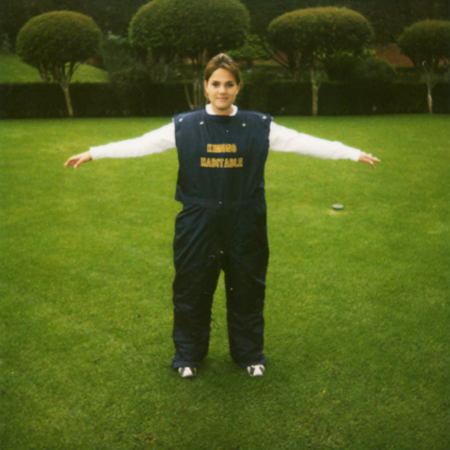
Our ninja Ivan Hernandez Quintela of Ludens [our first ‘Ninja of the Month’] contacted AMNP last week about new projects he’s worked on since the NotM feature – specifically, “The Box†@ MUAC. In addition to his own work, Ivan shared work done by student who participated in a “Guerilla Architecture” course which he taught at the Universidad Iberoamericana in Mexico City.

Ivan’s students were asked to produce temporary shelters that would meet the needs of one of several ‘homeless profiles’ that the class recognized, and then construct and test the design. Both designs featured here attempt to “make evident that the homeless are not inactive people, but actually are extremely mobile, nomad by nature” – creating solutions that take into account this mobile nature of many of the homeless.
The idea was that the homeless citizen would wear the kimono during the day and would remove it during the night to create his temporary shelter.
A garment that could be worn by day, and then reassembled into a tent structure – the first design uses lines to attach to nearby objects in order to create a shelter from wearable materials, rather than using poles or other rigid, harder to carry methods. The homeless citizen then wears her shelter on her person, saving the energy and space needed to transport something larger/heavier.

Next we have a design that combines this idea of mobility and need for shelter with the additional need – in some cases – for storage.
The students generated a vehicle, which was activated in a very similar manner as a wheel chair, so it required quite an athletic user, where two huge truck wheels were recuperated from a dump site and assembled in such a manner that in the middle is the navigating chair, and each wheel is used either as a resting spot or as a can container.

::all images, info, and quotes courtesy of Ivan Hernandez Quintela::
Posted: June 30th, 2009
at 4:22pm by orangemenace
Categories: architecture,housing,featured ninjas,student,Ninjas of the Month
Comments: 1 comment
Ludens: “The Box” @ MUAC

Many of you [I hope] will remember our ninja – and self-described practitioner of ‘Aikido Architecture’ – Ivan Hernandez Quintela from AMNP’s first Ninja of the Month feature, where we looked at the work of Ludens [click those sidebar links & images, people]. I was recently contacted by Ivan about some of his latest work, which we’ll see today and next week here on AMNP.
Those of you that are familiar with Ivan’s work [familiarize yourself] will know of his interest in transformable architecture that can adapt to multiple conditions and varying needs. This is exemplified in the project featured today – an educational center for MUAC [University Museum of Contemporary Art in Mexico City], which he refers to as ‘The Box’.

Designed by Teodoro Gonzáles de León, MUAC had a large, open, undefined space designated as an ‘educational area’ – within which a number of loosely defined activites would take place, oftentimes concurrently. Ludens was approached to design a structure that could inhabit this space and respond to the varying day-to-day needs of the ‘educational area’ – which could include several simultaneous small workshops, small lectures, interviews with local artists, and/or larger workshops/lectures/etc with more participants.

The idea was to offer a simple system of movement that could offer a wide range of spatial flexibility.
As a response, Ivan created a white box in the center of the space, made up of four large white ‘L-shaped’ sides. These ‘L-shaped’ sides can then rotate out into a number of varying configurations [seen in the plan sketch, above], accommodating the varying daily needs of the space.
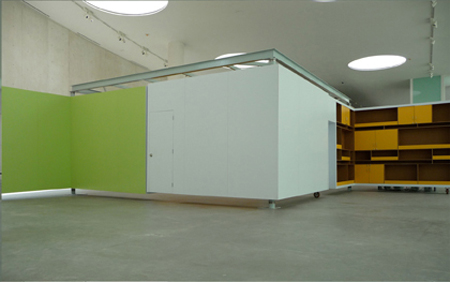
Each L-shape side, white on its exterior and colored and furnished on its interior, is capable of being rotated on its intersecting axis in order to open up and create different spatial compositions, where each spatial composition creates a different scenario. One could have a completely open space, or two semi open spaces, of four small and separate spaces each being supported by whatever surface one needs, white for projections, orange or green for hanging material with magnets, or shelves if production material is needed.
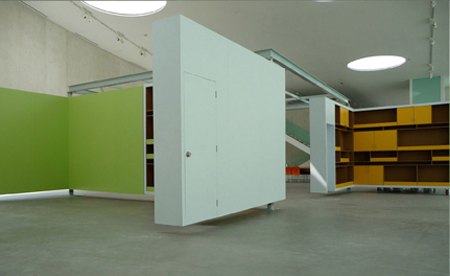
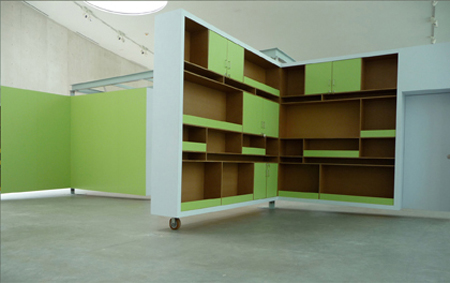
View more of Ivan/Ludens’ work at his website – and / or check out coverage of other selected works here at AMNP’s NotM: Ludens. And check in next week – we’ll be featuring the work of some of Ivan’s students from Universidad Ibero Americana in Mexico City, who took his “guerrilla architecture” course.
::all images + quoted text provided by Ludens::
Posted: June 23rd, 2009
at 1:07pm by orangemenace
Categories: architecture,interiors,featured ninjas,Ninjas of the Month,museum
Comments: 3 comments
NotM Dan Hisel: de Manio/Downing

[image: entry stairs to porch]
Designed for a family of 4, the de Manio/Downing Residence is a single-family home occupying a 5-acre, wood site outside Boston. Meeting the demands of the contemporary family, the home’s program called for 4 bedrooms, a large, formal living/dining space for entertaining, more casual spaces for the family’s day-to-day activities, and home offices for both parents.

[image: exterior view from north, across courtyard]
Dan Hisel, our current Ninja of the Month, saw the project as two connected volumes, “highly crafted boxes in the woods”, which are connected by a shared entry/porch space. These ‘boxes’ then form an L-shaped plan for the house, an underutilized [in the US, at least] housing typology that really locks the home into the landscape – as if placing the building in the site rather than on it. This relationship between the two volumes allows for an entry stair [seen above] that moves along the smaller ‘box’, directing you towards a centrally-located entrance in the main, larger ‘box’. It also creates an entry courtyard space for the family, which – when the trees have had a few more years to grow – will be like walking through their own personal, domesticated woods to enter the house.

[image: exterior view from south]
The design solution places 2 highly crafted boxes in the woods whose entry sequence orchestrates a dramatic threshold welcoming people into the forest. These two volumes adopt three primary orientations corresponding to the different activities engaged by this active household: a formal entertaining space and a library for adults directed towards views of the woods, informal kitchen and family/breakfast spaces oriented towards the large yard, and offices in and over the garage, oriented towards the public zones of the street and driveway.
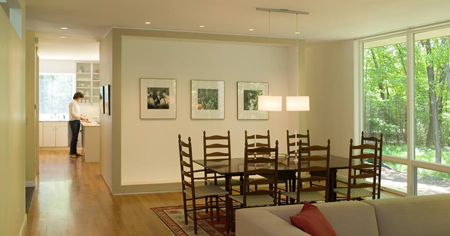
[image: living / dining looking towards kitchen]
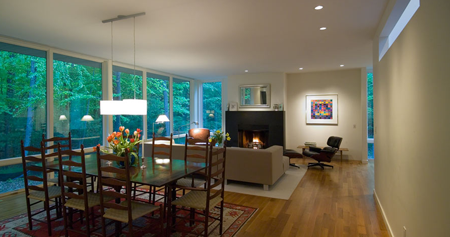
[image: living / dining]
Looking to the plans [below], we can see that the combination of the home and the office is handled through what could be seen as a more ‘urban’ strategy than you would typically see in a single-family residence in the woods: the home and office share a common porch, accessed through a shared public space [the courtyard]. The office space is even provided large windows looking out onto the entry stair, much like one would expect to find in a building attempting to engage with pedestrians on a sidewalk.
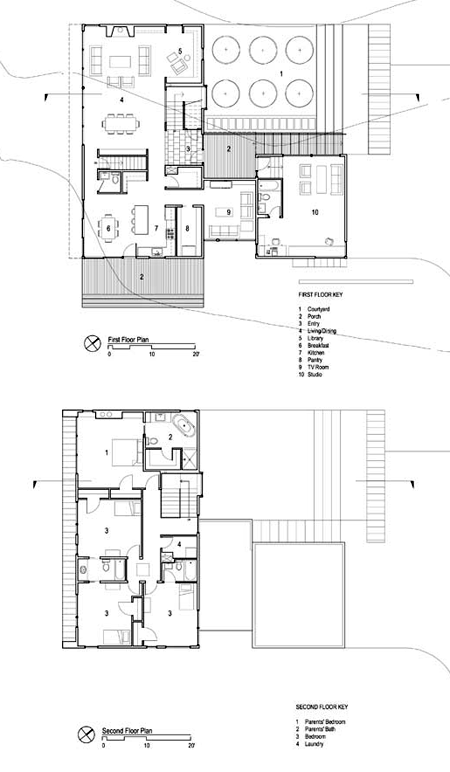
[image: first + second floor plans]
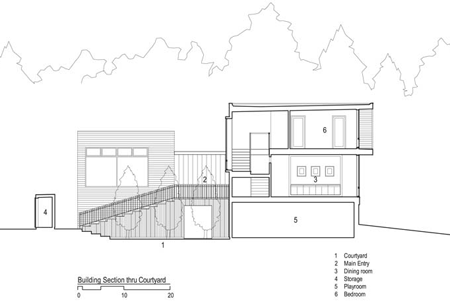
[image: section]
View more of Dan Hisel’s work – and more images of the de Manio/Downing Residence – at his website – and / or check out coverage of other selected works here at AMNP’s NotM: Dan Hisel.
::all images + any quoted text provided by Dan Hisel::
::photography by Peter Vanderwarker::
Posted: June 18th, 2009
at 2:53pm by orangemenace
Categories: architecture,housing,featured ninjas,Ninjas of the Month
Comments: No comments
NotM Dan Hisel: RAW Art Works

Located in Lynn, MA, RAW Art Works strives to provide local youth with ‘a creative home where they can safely explore difficult personal and community issues through the creation of art’. Our featured Ninja of the Month, Dan Hisel, was asked by the organization to re-imagine the first floor of their building, located in Central Square – an area currently undergoing a revitalization led by local artists and cultural organizations.

The space was designed to function as both a studio space for the young artists, as well as a gallery for exhibitions. As is fairly standard for a gallery, the space is left as open as possible – white walls with an open floor plan. In order to bring some interest to the space, and to engage the public – specifically the street, as this is on the center’s first floor – Hisel has created a steel frame, or ‘box’, which he has inserted into the façade.

This box box serves the initial purpose of opening the center to the street, creating a visual connection with the square and it’s pedestrians – which it takes one step further, by literally opening out the the sidewalk. The interior of the box then features a raised platform, allowing the center’s façade to serve both as a storefront, displaying student work to passers-by, and as a stage opening to the street [above].

Alternately, the platform can be used as a stage to address visitors assembled within the gallery Рor to play movies/video installations [above+below]. In another move to draw pedestrians into the gallery, the screen that descends is translucent Рallowing passers-by to view whatever visitors within the gallery are watching, essentially transforming the fa̤ade itself into a street-side movie screen.

When not in use as a ‘stage’, this platform can be rearranged to create pedestals and/or tables, and reveal bench seating along the window – creating a type of lounge / reception space for visitors in the front of the gallery.

Essentially, the project is an attempt to place the gallery itself – in it’s entirety – on display to the square. In doing so, the center distinguishes itself from surrounding storefronts, while expressing it’s desire to interact directly with the local community – both to ‘show off’ the work of the young artists, and to encourage community participation in RAW Art Works programs.

View more of Dan Hisel’s work at his website – and / or check out coverage of other selected works here at AMNP’s NotM: Dan Hisel Architect.
::images and any quoted text provided by Dan Hisel::
Posted: June 3rd, 2009
at 1:29pm by orangemenace
Categories: architecture,interiors,featured ninjas,Ninjas of the Month
Comments: No comments
NotM Dan Hisel: Z-Box 2
[youtube]http://www.youtube.com/watch?v=cXaqE2xUHkI[/youtube]
Many of you will be familiar with Dan Hisel’s first Z-Box, which you may have sen featured on AMNP a few years back. Built in Lynn, MA, the original Z-Box was constructed by Dan himself, and assembled entirely on-site.
When a second Z-Box was requested, this time for a new client in Albany, Hisel built upon what he had learned through building the original – namely, that pre-fab was the way to go. While designed to meet a different set of client needs [different sized bed, new storage requirements, etc], one of the most striking differences between the Z-Box 2 and the original is that it’s components were fabricated by a company called Continental Consolidated Industries from Worcester, MA. Built of perforated steel, translucent fiberglass, and oak veneer plywood, the Z-Box 2 was designed and constructed as a dozen ‘chunks’ that could be easily transported and carried through a standard doorway. These ‘chinks’ were completed, shipped, and assembled in the client’s loft space in Albany – with on-site assembly being completed in under 48 hours.
::video provided by Dan Hisel Architect::
Posted: May 26th, 2009
at 12:14pm by orangemenace
Categories: architecture,pre-fab,housing,interiors,featured ninjas,videos,Ninjas of the Month
Comments: 1 comment
NotM: Dan Hisel Architect
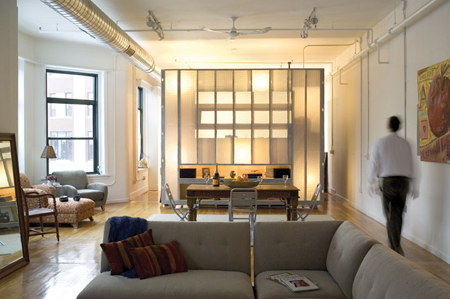
[Image: Z-Box]
Welcome to the start of the third installment of our continuing AMNP feature, Ninja(s) of the Month.
This month we’ll be featuring the work of Boston based Dan Hisel Architect [DHA]. Dan received his undergraduate degree from the University of Kentucky and a Masters of Architecture with distinction from Yale – and went on to start his own practice in 1996, then Dan Hisel Design, with the design and construction of the Cadyville Sauna in upstate New York. Self-described as being “committed to the enrichment of contemporary life through the poetic articulation of spatial experience”, DHA’s practice covers a wide spectrum of projects – from furniture, to private residences, to commercial and institutional projects.

[Image: Cadyville Sauna]
Our design approach to each project emerges from a clear understanding of the life to be lived (the client’s needs, routines, and rituals), the intricacies of the specific site, the creative milieu of our contemporary culture, the urgency of sustainable building practices, and the ever-present constraints of time and money. The goal is always to arrive at original solutions that resonate in meaningful ways with those who encounter them. Sometimes the poetic idea is a simple one: make the building act as a frame, for example, in order to foreground the activities of kids in an art school. Sometimes it is more existential: make the building disappear altogether. Regardless of the tactic, the strategy remains the same: minimal gestures for maximal effect.
~Dan Hisel, Dan Hisel Architect
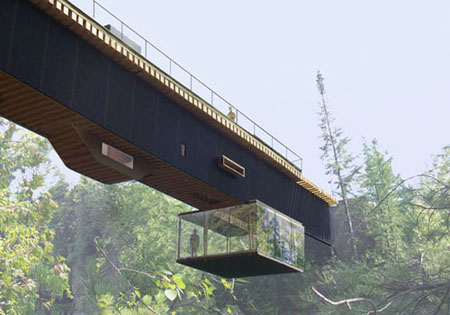
[Image: Heavy/Light House]
Many of you will be familiar with a number of Hisel’s projects, in particular the Cadyville Sauna and the Heavy/Light House – the latter of which won a number of awards including a Progressive Architecture Award Citation and a Boston Society of Architects award for unbuilt architecture [both in 2004]. Hisel was also named a winner of the Young Architects Forum by the Architectural League of New York in 2005 – and subsequently published in Young Architects 7: Situating. Additionally, readers of AMNP will remember Dan for the Z-Box, which we featured in 2007.

[Image: 9 Salem]
In addition to his practice, Dan is currently an Adjunct Faculty member at Wentworth Institute of Technology in Boston – and has taught previously at Roger Williams University [where I met him], California College of the Arts in San Francisco, Syracuse University, Catholic University, and Iowa State University.
AMNP is pleased to announce that over the next few weeks we’ll be looking at a number of DHA’s other projects – including a second Z-Box, a private residence in MA, an art center in Lynn [MA], and some of Dan’s own writing / work dealing with the history and theory of camouflage in architecture.
Posted: May 19th, 2009
at 5:00am by orangemenace
Categories: architecture,featured ninjas,firm profile,Ninjas of the Month
Comments: No comments




